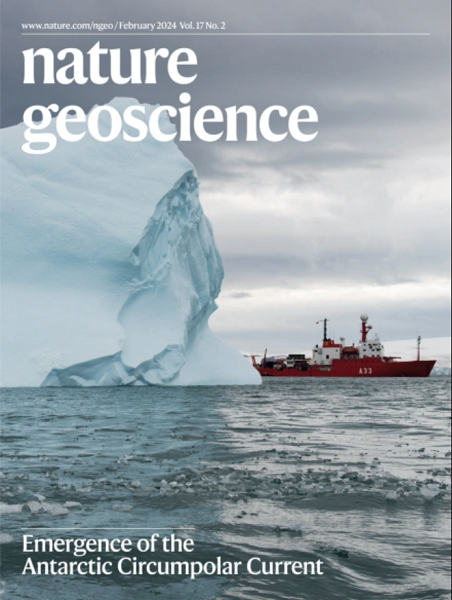碳循环的百年尺度变化因高倾角而增强
IF 15.7
1区 地球科学
Q1 GEOSCIENCES, MULTIDISCIPLINARY
引用次数: 0
摘要
在退冰期、冰川期和间冰期发现了大气中二氧化碳百年尺度的增加,称为二氧化碳跃变,并与北半球气候突变有关。然而,由于已发现的二氧化碳跃变数量有限,因此无法研究轨道背景条件对全球碳循环不同组成部分的作用,而这些作用可能会导致大气中二氧化碳的快速释放。在这里,我们展示了在 26 万年前到 19 万年前的南极冰芯上测量到的高分辨率二氧化碳记录,该记录揭示了另外 7 次二氧化碳跃迁。在过去 50 万年中发现的 22 次跃迁中,有 18 次发生在高倾角背景下。利用中等复杂程度的地球系统模型进行的模拟表明,南大洋和大陆生物圈是与海因里希冰漂移事件相关的二氧化碳跃迁过程中的两个主要碳源。值得注意的是,在这些突变事件中,大陆生物圈似乎是与倾角有关的二氧化碳源。我们证明,轨道尺度的外部强迫直接影响了过去大气二氧化碳的突变。本文章由计算机程序翻译,如有差异,请以英文原文为准。


Centennial-scale variations in the carbon cycle enhanced by high obliquity
Centennial-scale increases of atmospheric carbon dioxide, known as carbon dioxide jumps, are identified during deglacial, glacial and interglacial periods and linked to the Northern Hemisphere abrupt climate variations. However, the limited number of identified carbon dioxide jumps prevents investigating the role of orbital background conditions on the different components of the global carbon cycle that may lead to such rapid atmospheric carbon dioxide releases. Here we present a high-resolution carbon dioxide record measured on an Antarctic ice core between 260,000 and 190,000 years ago, which reveals seven additional carbon dioxide Jumps. Eighteen of the 22 jumps identified over the past 500,000 years occurred under a context of high obliquity. Simulations performed with an Earth system model of intermediate complexity point towards both the Southern Ocean and the continental biosphere as the two main carbon sources during carbon dioxide jumps connected to Heinrich ice rafting events. Notably, the continental biosphere appears as the obliquity-dependent carbon dioxide source for these abrupt events. We demonstrate that the orbital-scale external forcing directly impacts past abrupt atmospheric carbon dioxide changes. Centennial-scale releases of atmospheric CO2 occurred during periods of high obliquity over the past 500,000, suggesting a link between external forcing and atmospheric CO2 variations, according to a record from an Antarctic ice core.
求助全文
通过发布文献求助,成功后即可免费获取论文全文。
去求助
来源期刊

Nature Geoscience
地学-地球科学综合
CiteScore
26.70
自引率
1.60%
发文量
187
审稿时长
3.3 months
期刊介绍:
Nature Geoscience is a monthly interdisciplinary journal that gathers top-tier research spanning Earth Sciences and related fields.
The journal covers all geoscience disciplines, including fieldwork, modeling, and theoretical studies.
Topics include atmospheric science, biogeochemistry, climate science, geobiology, geochemistry, geoinformatics, remote sensing, geology, geomagnetism, paleomagnetism, geomorphology, geophysics, glaciology, hydrology, limnology, mineralogy, oceanography, paleontology, paleoclimatology, paleoceanography, petrology, planetary science, seismology, space physics, tectonics, and volcanology.
Nature Geoscience upholds its commitment to publishing significant, high-quality Earth Sciences research through fair, rapid, and rigorous peer review, overseen by a team of full-time professional editors.
 求助内容:
求助内容: 应助结果提醒方式:
应助结果提醒方式:


